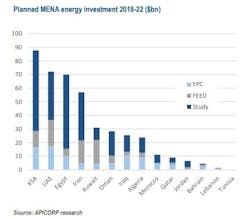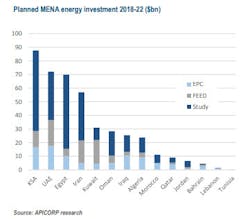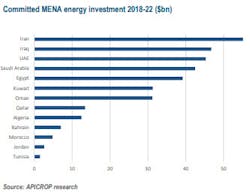The Middle East and North Africa (MENA) region will see a number of critical energy projects pushed through over the next five years, despite uncertainties that cloud the investment outlook, according to APICORP Energy Research.
Around $345 billion has already been committed to projects under execution while an additional $574 billion worth of development is planned, according to data from APICORP. Leading the drive will be Saudi Arabia, which along with the rest of the GCC will invest across the energy value chain.
By APICORP’s estimates, around 80% of the investments are government led whilst the remainder are a combination of either wholly private sector developments or public-private partnerships. Planned investments decreased by 8% whereas committed investments increased by 2% from its previous outlook. This represents the transition of many projects and investments from the planned to committed phase as contracts are awarded following a more positive outlook.
Meantime, while MENA is pushing ahead with its investment plans, APICORP believes that there will be many challenges and constraints. Long-term perception of risk about the oil industry, the uncertain economic outlook, and deteriorating geopolitical backdrop all have an impact on planned investments.
Planned investments
Planned MENA investments in the energy sector are estimated at $574 billion for the next five years. The power sector accounts for the largest share of investments, at $187 billion. The oil and gas sectors will represent $169 billion and $150 billion respectively, with the remaining investments in petrochemicals.
“Given the current investment climate and uncertain outlook, we do not anticipate that all projects under this phase will move to the execution phase. Contracts under design and EPC phases are more likely to materialize in the medium term. Projects under contract bid amount to $92 billion, while those under design reach $86 billion.” APICORP said.
Saudi Arabia and the UAE represent 38% of planned investments, with $149 billion and $72 billion respectively, over the outlook period, as both countries look to boost their upstream oil and gas sectors. Saudi Arabia has concrete plans to increase gas production and to promote the role of gas in its energy mix – which is currently diverted entirely for domestic use in power generation and industry, while ambitious plans to boost renewable energy generation are also moving forward.
Additionally, the country has many projects in the pipeline to add significant power generating capacity as peak load demand is estimated to reach 80GW by 2022. The Kingdom is also planning to continue investing in petrochemicals in its drive to diversify and create more value. Two major projects currently planned include the Jubail Oil-to-Chemical Complex and the Yanbu Integrated Refinery & Petrochemicals Complex.
Planned investment in UAE is $72 billion, of which $17 billion is at the contract-bidding phase. The ADCO consortium - which accounts for more than half of the UAE’s oil output - will drive up upstream investment.
Additionally, UAE plans significant downstream investments in expanding their refining and petrochemical sectors – with the Ruwais Refinery upgrade and the Borouge Petrochemicals Complex representing some of the largest projects.
For Egypt, the main concern is ramping up gas production and rising power demand. Planned investments in the country are $72 billion, with the power sector making up over 50% of the total.
In Kuwait, planned projects over the period stand at $59 billion, with over 50% in the oil sector. More specifically, the country intends to increase oil output to 4 million b/d within APICORP outlook and achieve non-associated gas capacity of 2.5 bcfd by 2030. In petrochemicals, the Al-Zour Petrochemicals Complex is likely to go ahead with an estimated cost $6 billion, with contracts expected to be awarded in 2019.
In Algeria, a sharp fall in export revenues is threatening fiscal balances and investment programs. Planned projects stand at around $58 billion with the Hassi Messaoud Peripheral Field Development accounting for a significant portion of investments in upstream oil. The country will seek to invest in upstream oil and gas to meet its target of increasing production by 20%. A series of downstream projects totaling $8 billion are planned, including the Hassi Messaoud and Tiaret refineries.
For Iran, total planned investments are $57 billion, of which the majority will go towards oil and gas projects. This highlights the country’s aspiration to boost its oil and gas sectors with major projects including the North Pars gas development and the $4.5 billion Kish gas development.
Since the removal of sanctions last year, the government has not been successful in attracting much needed foreign investments due to several political and economic challenges. Iran will also need to maintain its commitments to the letter under the nuclear agreement to avoid the “snap-back” of sanctions.
Iraq’s planned projects currently stand at $37 billion, a figure weighed down heavily by political, economic and security risks. Meanwhile, low oil prices have been damaging the government’s budget, despite rapid production growth over the past few years. To maintain these high levels of production, the country and IOCs will need to continue investing in upstream development.
Planned projects for the remaining GCC countries will reach $57 billion.
Committed investments
Investments in the energy projects currently under execution are estimated at $345 billion for the five-year period. The oil sector accounts for the largest share of investments at $131 billion, with the majority in upstream projects. Total committed gas and power investments are approximately $106 billion and $95 billion respectively, followed by chemicals at $14 billion. The GCC represents $171 billion in committed investments, approximately 50% of the MENA total.
Iran leads the region with an estimated $67 billion, mostly focused on the oil and gas sector. The country has prioritized the development of phase 12 of the South Pars gas field, where around $10 billion will be invested over the outlook period. In upstream oil, the focus will be on the West Karun oil fields, particularly South Yaran and South Azadegan, which will contribute further to Iran’s short-term output-capacity growth. In the downstream, the Siraf refinery project, with a budget of $2.4 billion, will increase capacity by up to 480k b/d.
Saudi Arabia has committed an estimated $42 billion for the outlook period, of which $14 billion will be in the power sector. The 4GW Jizan integrated gasification combined-cycle power plant will alone cost $8.5 billion. The remaining investments are spread evenly across oil and gas, with the $6.5 billion Fadhili gas plant, one of the largest investments coming on line in 2019.
In Egypt, committed investments stand at around $39 billion, with power-generation projects accounting for $18 billion. The renewable energy program is expected to account for a large sum of committed investments within outlook as the country aims to achieve its 20% clean energy target by 2022. In the gas sector, the BP-led West Nile Delta represents the majority of investment under execution.
Kuwait and Oman have committed $31 billion each. In Kuwait, downstream projects represent half of investments under execution. Major projects include the Al-Zour refinery and the Clean Fuels Project aimed at upgrading and expanding the Mina Abdulla and Mina Al-Ahmadi refineries. As for Oman, the government is prioritising investments in upstream gas. The BPled Khazzan and Makarem project is the largest gas development in the country, with estimated total spending of $13 billion within the outlook period. In downstream, the $7 billion Duqm refinery and petrochemical complex is expected to be completed in 2021.
In Qatar, the country has ambitious plans to invest in further oil and gas development, particularly the redevelopment of the Bul Hanine which is expected to more than double its existing capacity.
Algeria has committed $12 billion over the medium term. The majority of investments are in upstream and the power sector. In Morocco, investments are focused in power generation with renewable-energy projects, such as the Moroccan Solar Plan, at the forefront of its plans. Libya, Syria and Yemen - thwarted by ongoing civil wars - will see very little investment over the period.



